| Aug-26-07 | | laskereshevsky: <euripides>
In the game position:
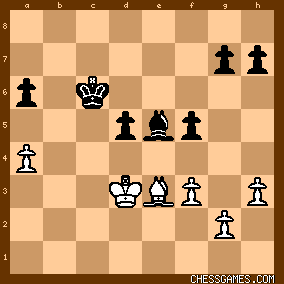
click for larger viewThe above winning line dsnt work with the p in f5 cause now white can play: 40.♗f2 ♗d6 41.♗d4 ♙g6 42.♗e3 ♗c5 43.♗g5 and the White♗ could disturb the Black♔ from rear. But even if Bondarevsky lost this chances, he had another winning move at the 53th move... 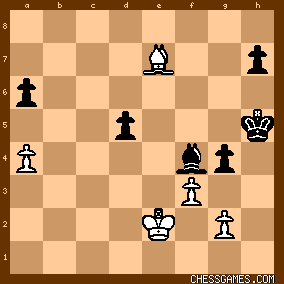
click for larger viewIn place of 53...♙g3?
53...♙gxf+ 54.♔xf3 ♗e5 55.♗d8 ♔g6 56.♗e7 ♔f5 57.♙g4+ (otherwise 57...♙h5)...♔g6 58.♗d8 ♗f6 59.♗a5 ♔g5 60.♗e1 ♙d4 <"Bondarevsky could have won another gruelling end-game from me in this tournament.
Now a draw is obvious, and Black's further efforts appear to be pointless"> BTW, <eur>, My pleasure.... |
Oct-30-23
 | | offramp:
David Hooper's analysis.
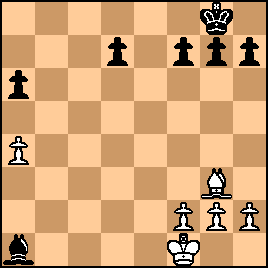
click for larger view
<When both sides have bishops a pawn up wins both more certainly and more directly than is the case with any other pieces, with the possible exception of bishop v. knight.
Not long before in this game each player had a rook, a queen,and a bishop. Black exchanged for preference the major pieces, leaving a bishop and pawn ending. In most endings the winning processes are the same. First the king and the other pieces must be centralized, brought to good squares where they have the greatest mobility, and be ready for active service on either flank.
32. Ke2.
The defender also centralizes.
32....f6
33. Kd3 d5
34. h3.
White correctly puts his pawns on white squares, where they do not impede the bishop.
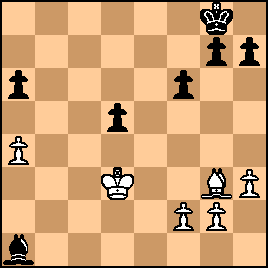
click for larger view
34...Kf7
35. f3 Ke6
36. Bf2 Kd6
37. Bg1.
Keeping out Black’s king.
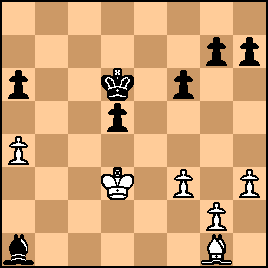
click for larger view
37...Be5
Centralizing the bishop.
38. Bf2 Kc6
39. Be3.
When the passed pawn is in the centre, or when there is a large number of pawns on the board, the attacker may have difficulty getting his king into the game, a problem especially prone to occur in bishop endings. Here Black’s king cannot easily support the further advance of the passed pawn, nor otherwise get round to attack White’s QRP.
39...f5.

click for larger view
Centralization is now complete.
The next stage is usually to make the extra pawn a real threat. This means making a passed pawn, or threatening to do so. In this case the passed pawn (QP) already exists.
As the passed pawn can rarely be forcibly queened, it is used to decoy the enemy pieces, or one of them. In the preceding example Black’s QRP decoyed White’s knight. If instead the passed pawn decoys or is blocked by the defending king, then the attacking king goes to the other side of the board and there mops up the pawns.
Thus positions with pawns on both sides of the board are easier to win—the decoy draws the defender’s forces farther away.
In the present case the passed pawn, which is always least favourable when in the centre, does not at the moment form an effective decoy, but might do so if the kings were elsewhere. With the text-move, 39...f5, Black therefore plans to move his king over to the king’s side with this end in view; and indeed this is the most systematic method, if not in this instance the quicker.\
The player with the extra pawn has the inherent advantage that he may offer an exchange of pieces, on the supposition that he can win the pawn ending; whilst if the defender declines to exchange, and withdraws his piece, then the attacker accordingly advances and improves his position. Botvinnik indicates how this
factor may here lead to a direct win:
39... Bd6 40. Bf2 Bc5 41. Be1 Kb6 42. Bd2 Bd6 43. Kd4 Kc6 44. Be1 Be5+ 45. Kd3 Kc5
Black has slightly improved his king’s position, but entry is not yet assured,
46. Bd2 Ba1 47. Be1 d4 48. Bd2 Bc3.
and now White must allow Black’s king to attack the QRP, or play 49. Bxc3 dxc3 50. Kxc3 a5
after which Black wins the tempo-struggle, thereby gains the opposition, and finally advances his king into the enemy position.
Although not always available, opportunities of returning the extra pawn must not be overlooked. |
Oct-30-23
 | | offramp:
<
<To summarize, the player with the pawn up has in consequence two positional advantages: his pawn may itself be a threat; or he may offer to exchange pieces, the declension of which improves
his game.>
40.Bf2 Kd6
41.Ba7 Ke6
42.Be3 Kf6
43.Bd2 Kg6
44.Ke2 Kh5
45.Be1 Kg5
46.Bd2+ Kh4
47.Be1+ Bg3
48.Bc3 g5
49.Bd4 g4.

click for larger view
Whether he likes it or not Black will have to exchange some pawns to force his king into the game. In one way at least this suits White, who may yet hope to draw by exchanging off all the pawns.
50.Bf6+ Kh5
51.hxg4 fxg4.
52. Bd8 Bf4
53. Be7 g3.
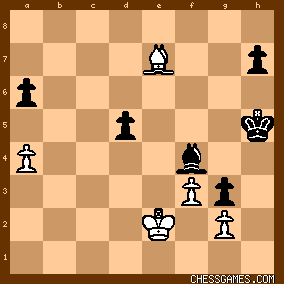
click for larger view
In the game Black played 53...g3? He was seduced by the tactical possibilities of a sacrifice of his KRP (♙h7-h5-h4) creating a passed KKtP. The game went on for 21 moves before a draw was agreed, White stopping the QP with his king
54.Kd3 Kg6 55.Kd4 and holding up Black’s KRP with his bishop.
55...Kf7 56.Bh4 Ke6 57.Bd8 h5 58.Bh4.
Black’s play was inconsistent, for the move he chose deprived his king of the chance of entering White’s half of the board, which was surely the main purpose of his previous manoeuvring. [In analysis] 53... gxf3+ 54. Kxf3 Be5 55. Bd8 Kg6 56. Be7 Kf5 57. g4+ [Else Black plays ... h5.] ...Kg6 58. Bd8 Bf6 59. Ba5 Kg5 60. Be1 d4 [The culmination of Black’s plan. Now that the kings are on the king’s side, the passed centre pawn becomes an effective decoy.]
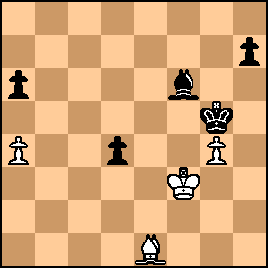
click for larger view
61. Bd2+ [<If 61. Kg3 Be5 62. Kf3 Bf4 63. Ba5 d3>]
61...Kh4 62. Be1+ Kh3 63. Bd2 d3 64. g5 Bd8 65. Ke4 Kg4.
[<After which Black’s king decisively enters, but if 34. Bf4 Ba4, followed by
35... d2.>]
66. Kxd3 Bxg5 67. Be1 h5...
And Black wins.> |





